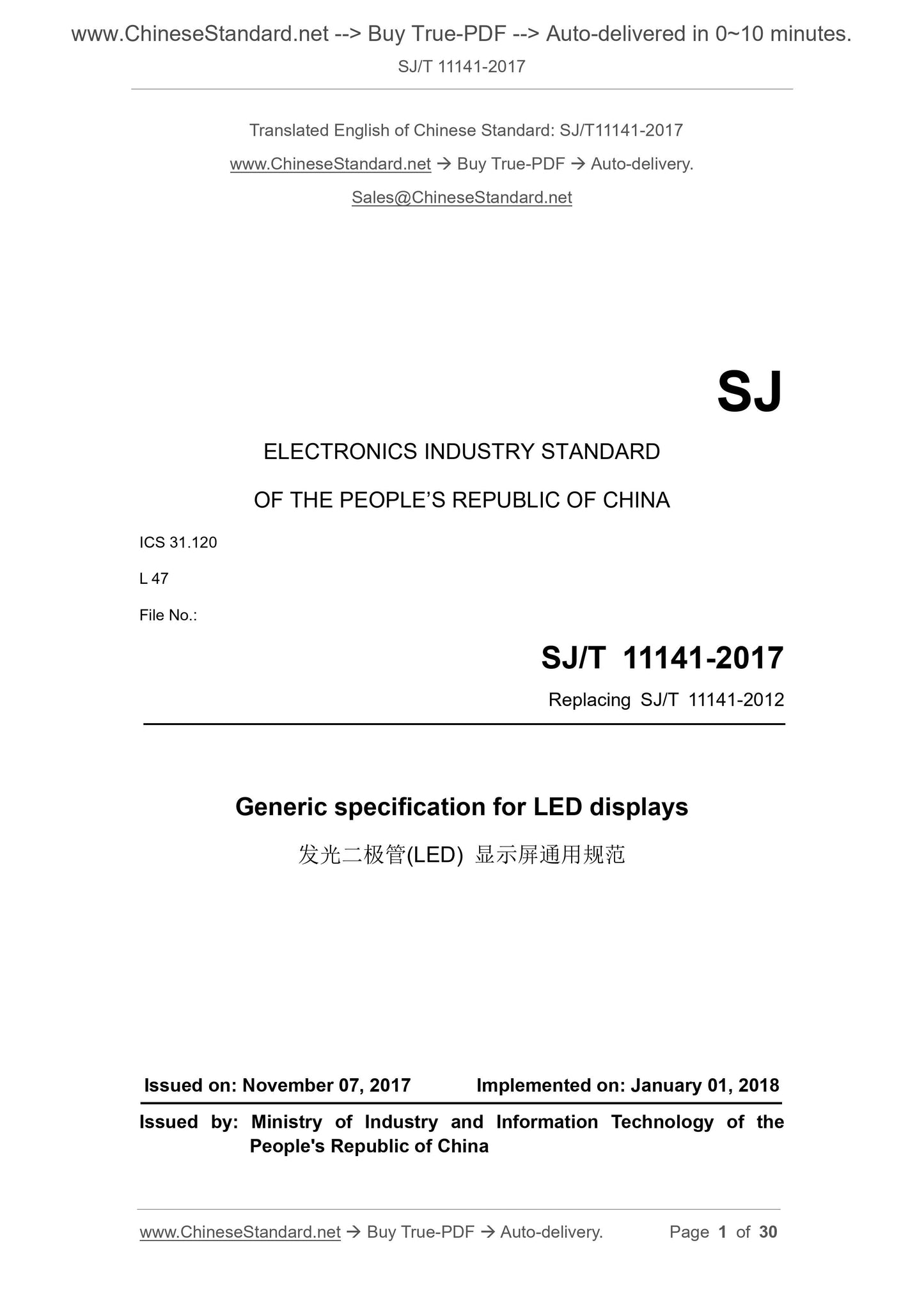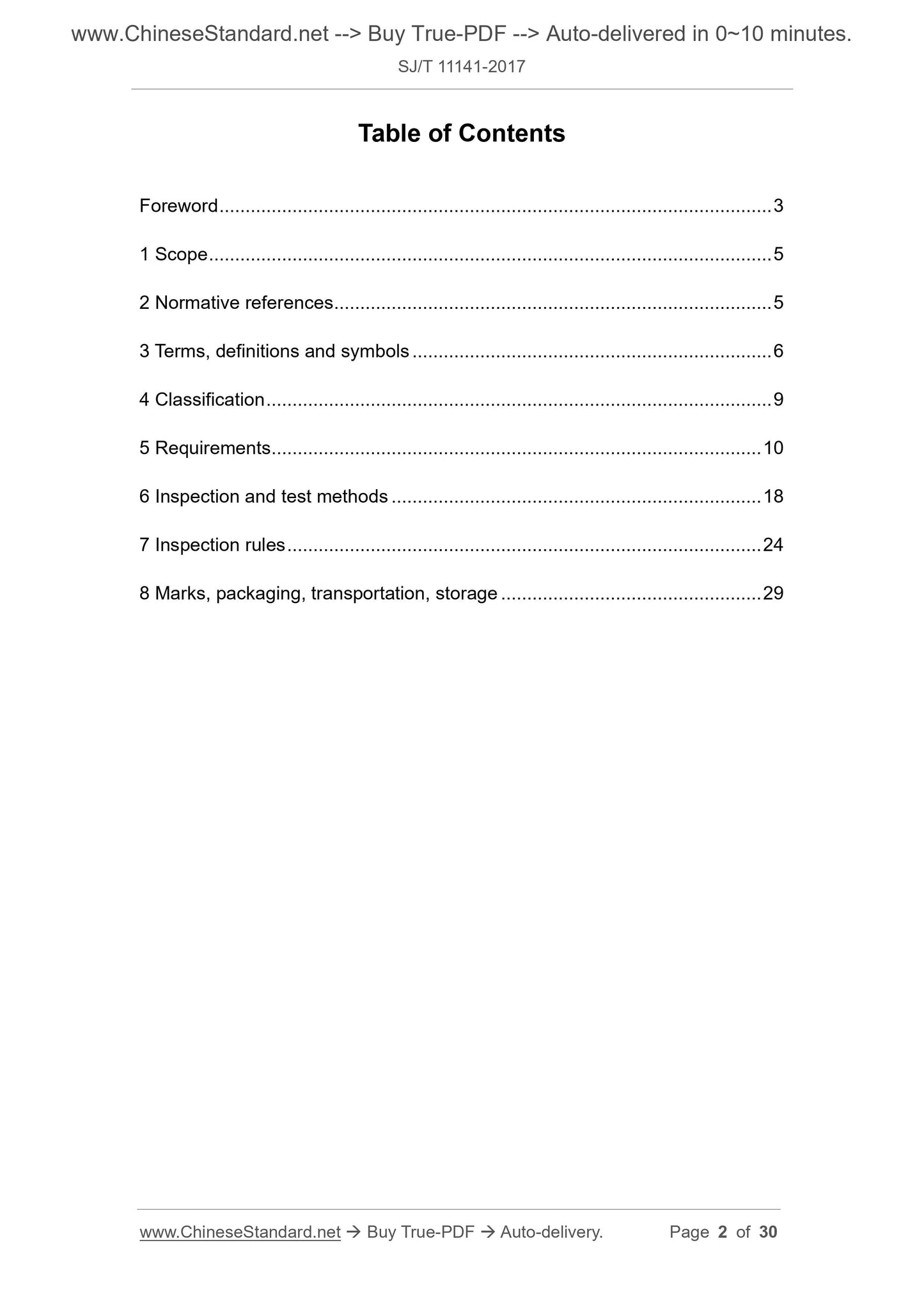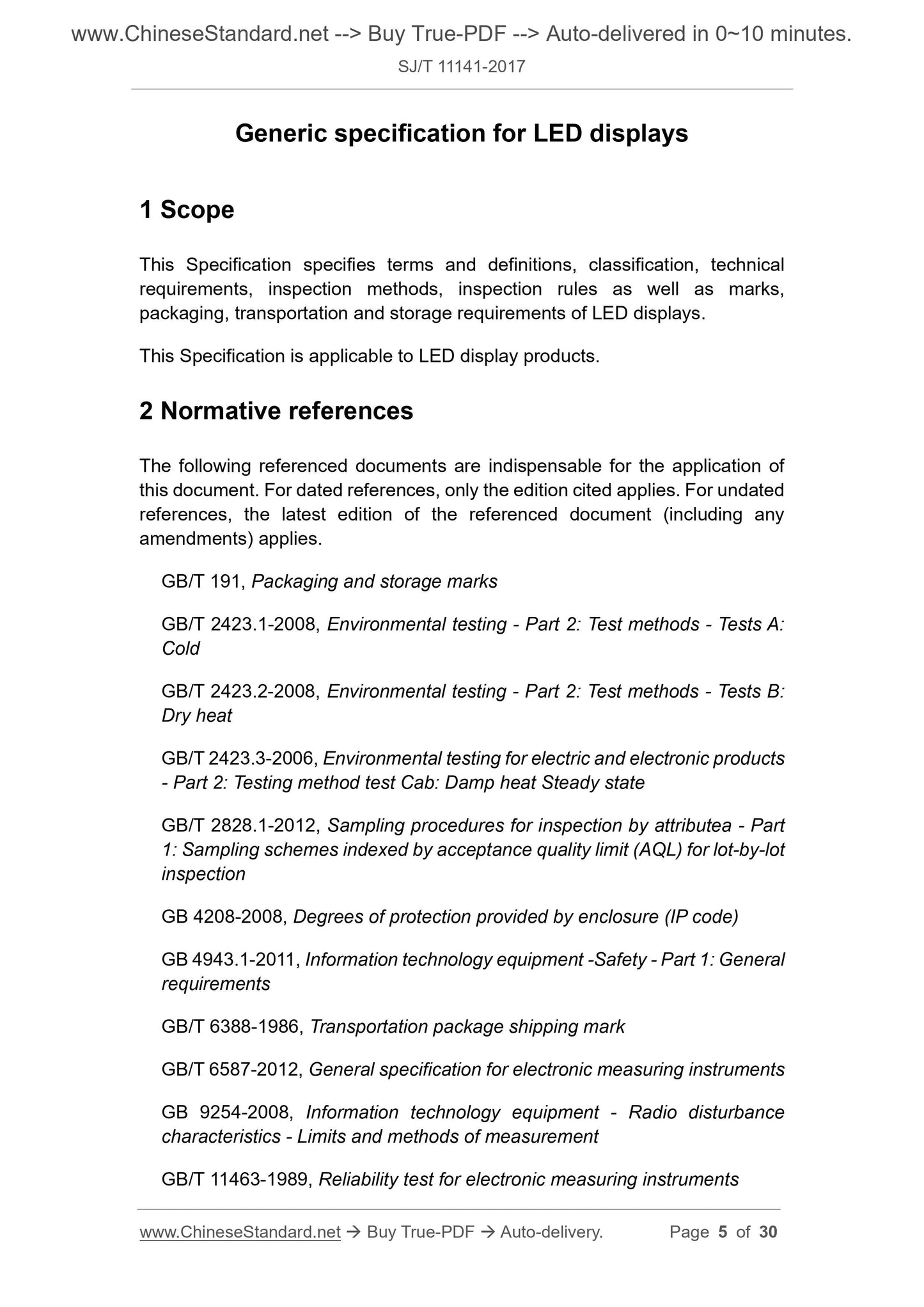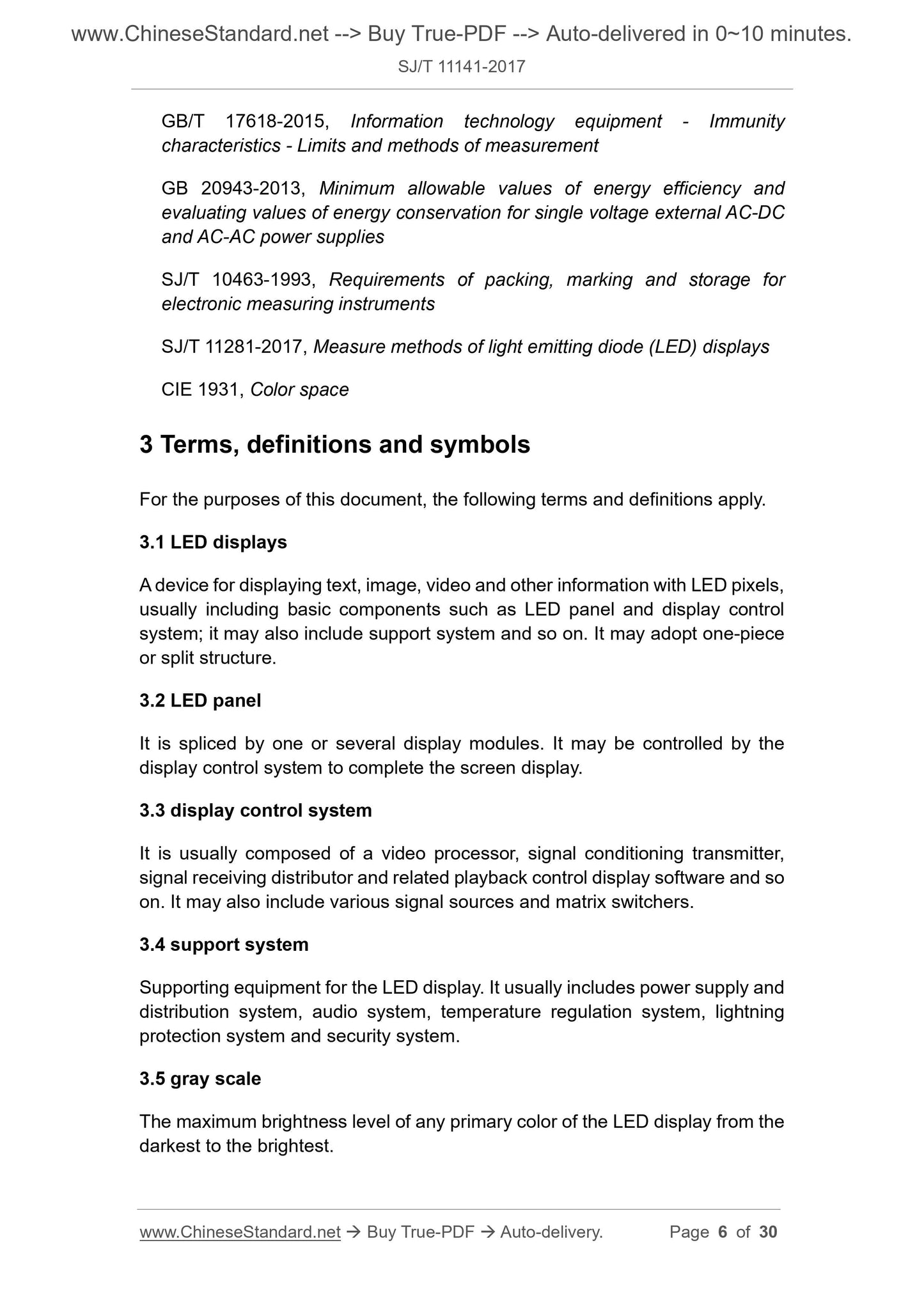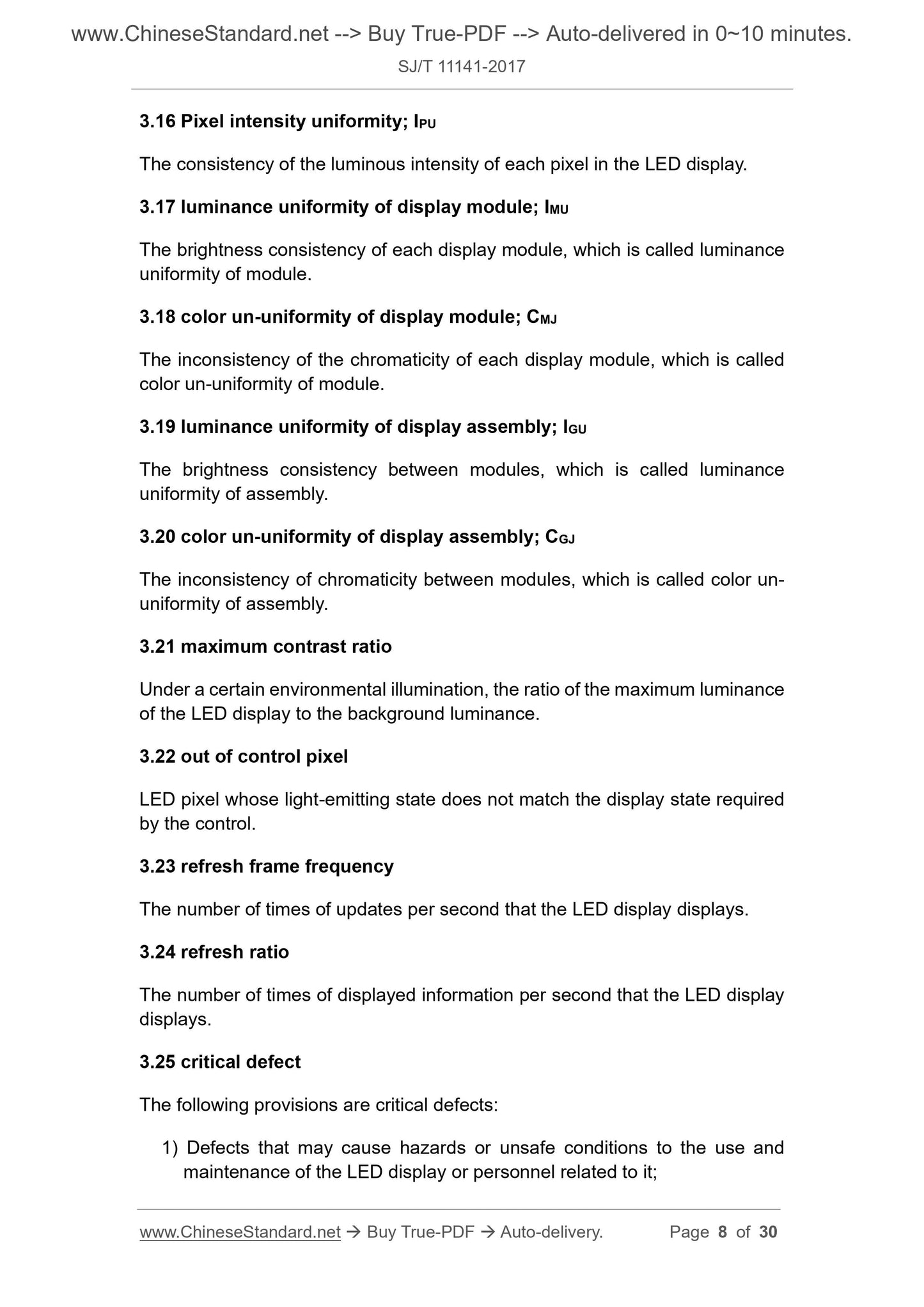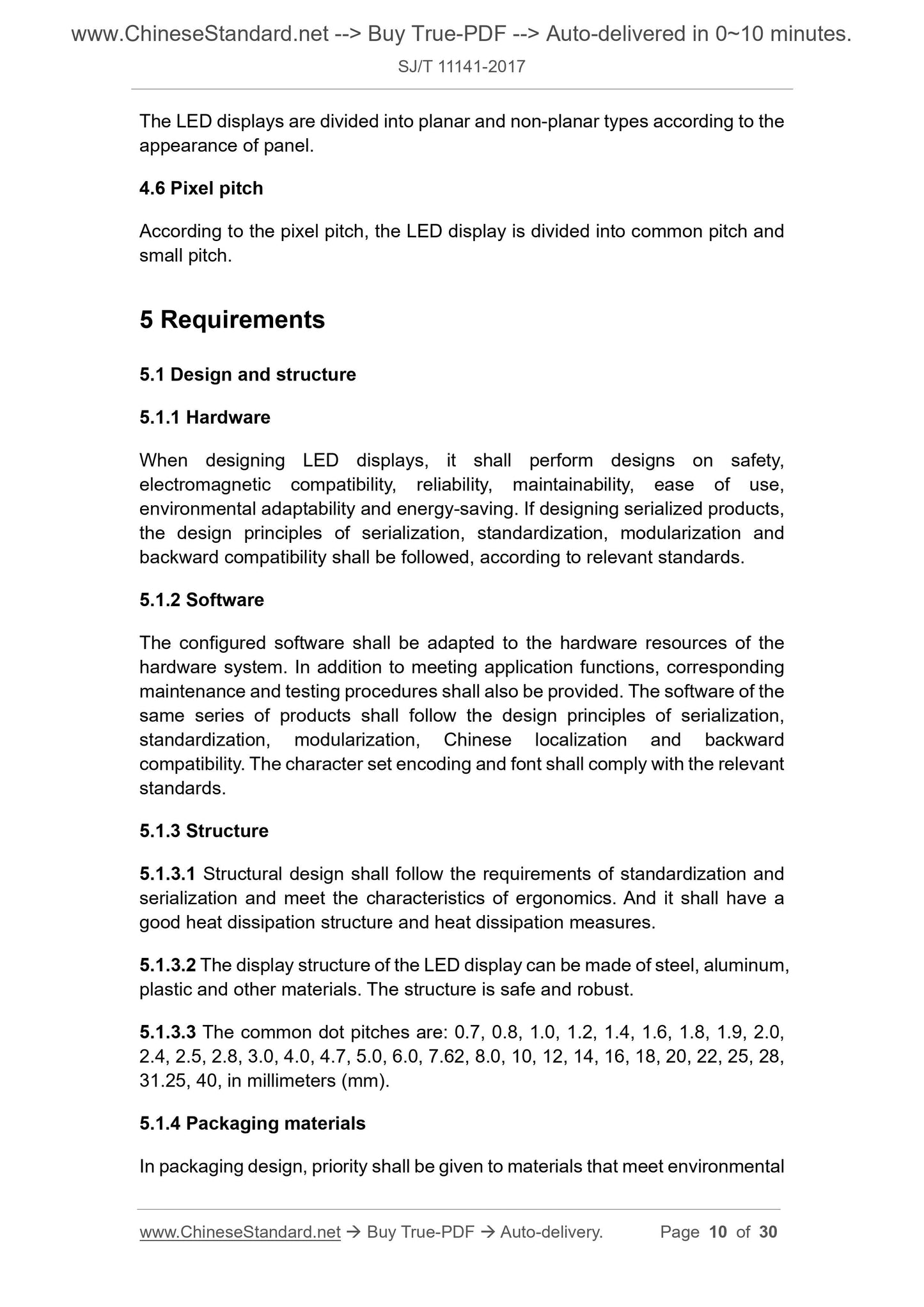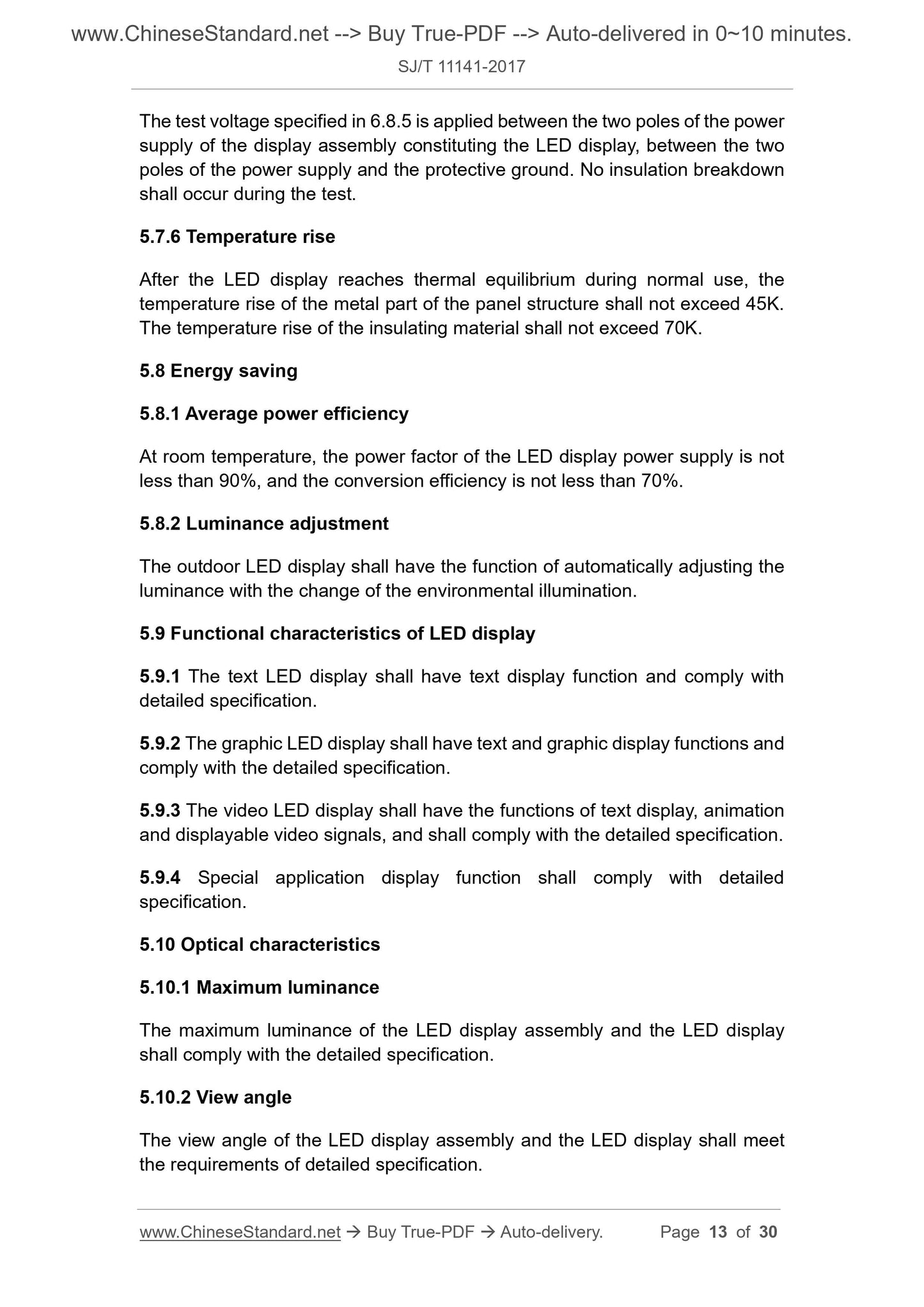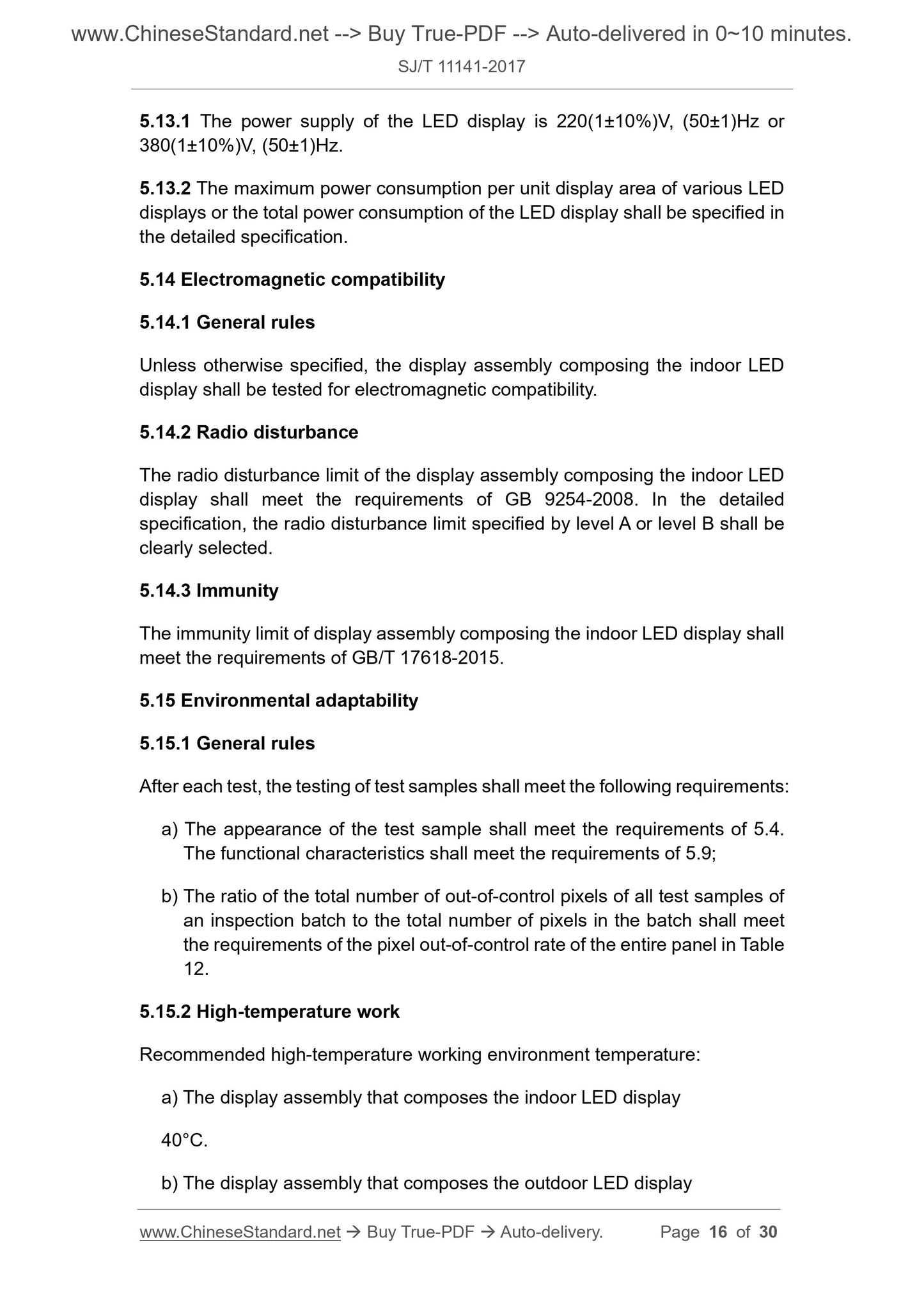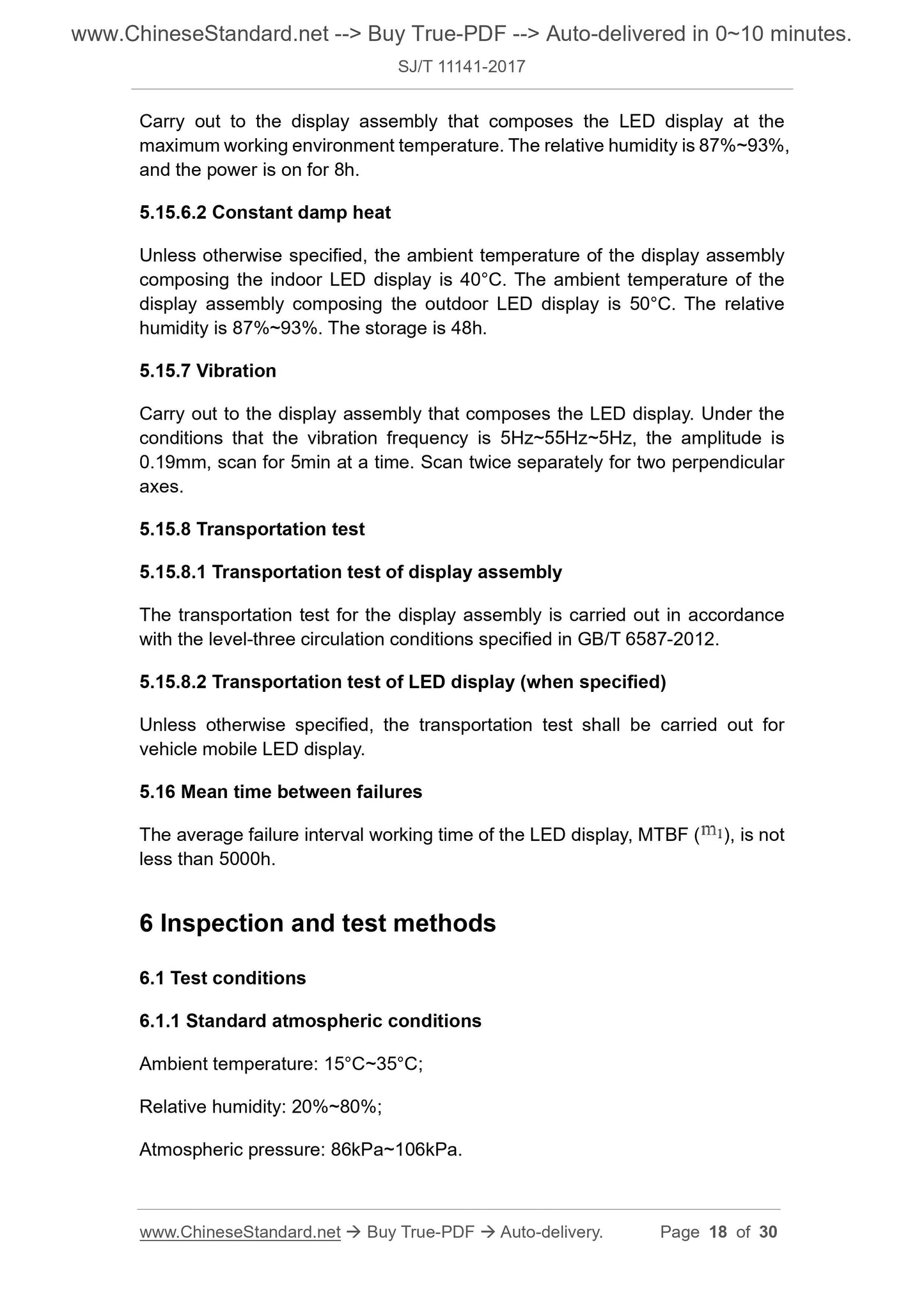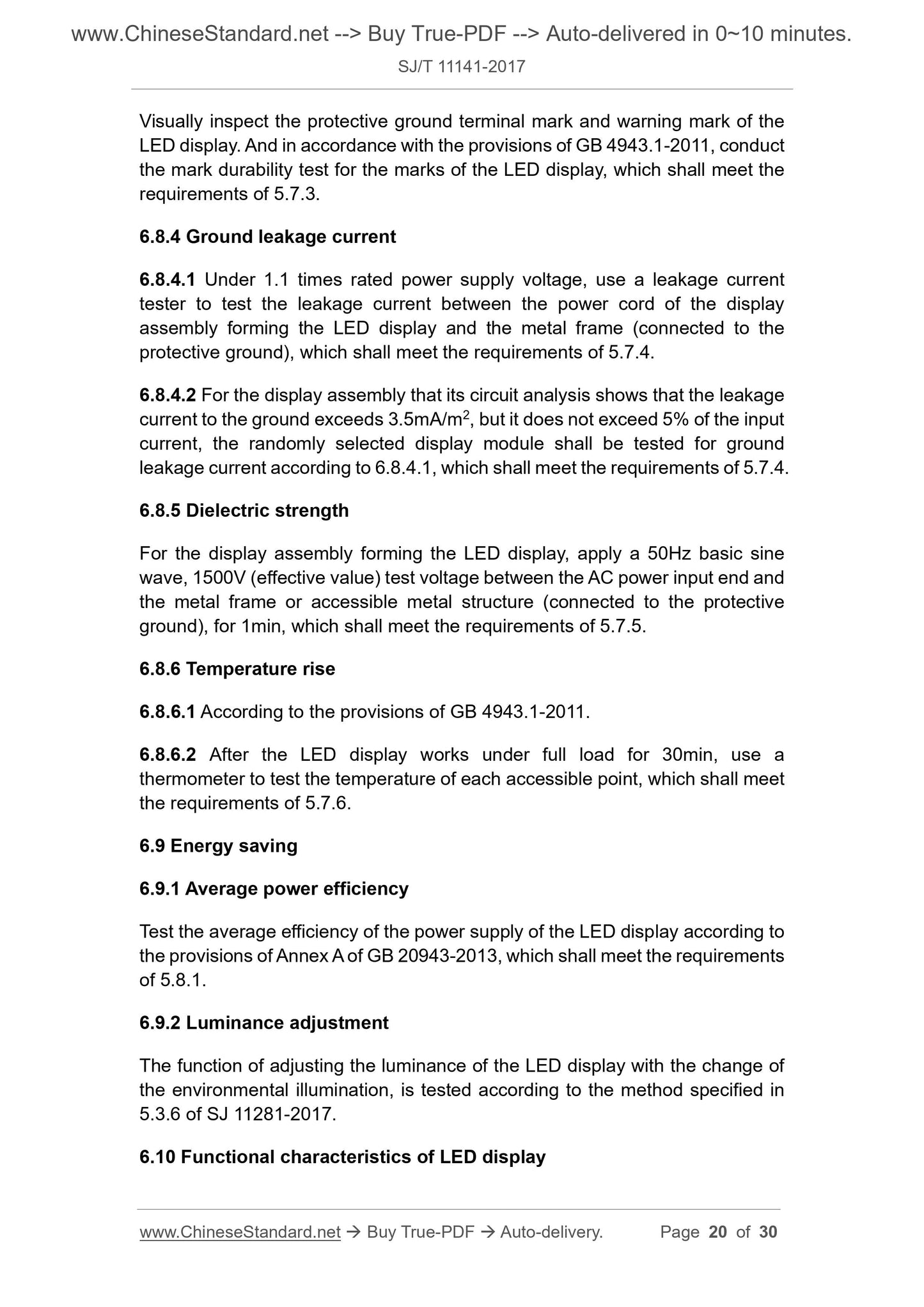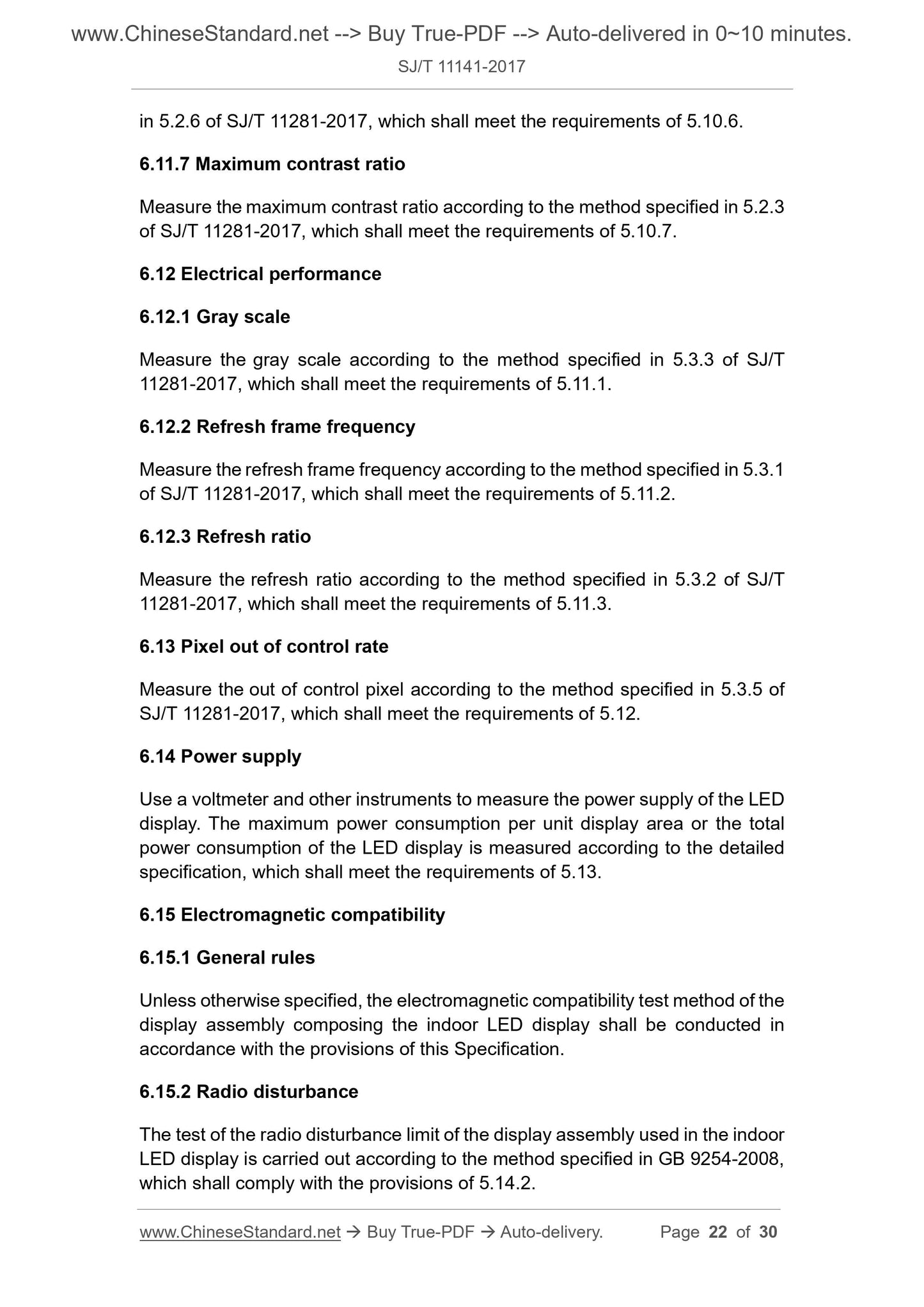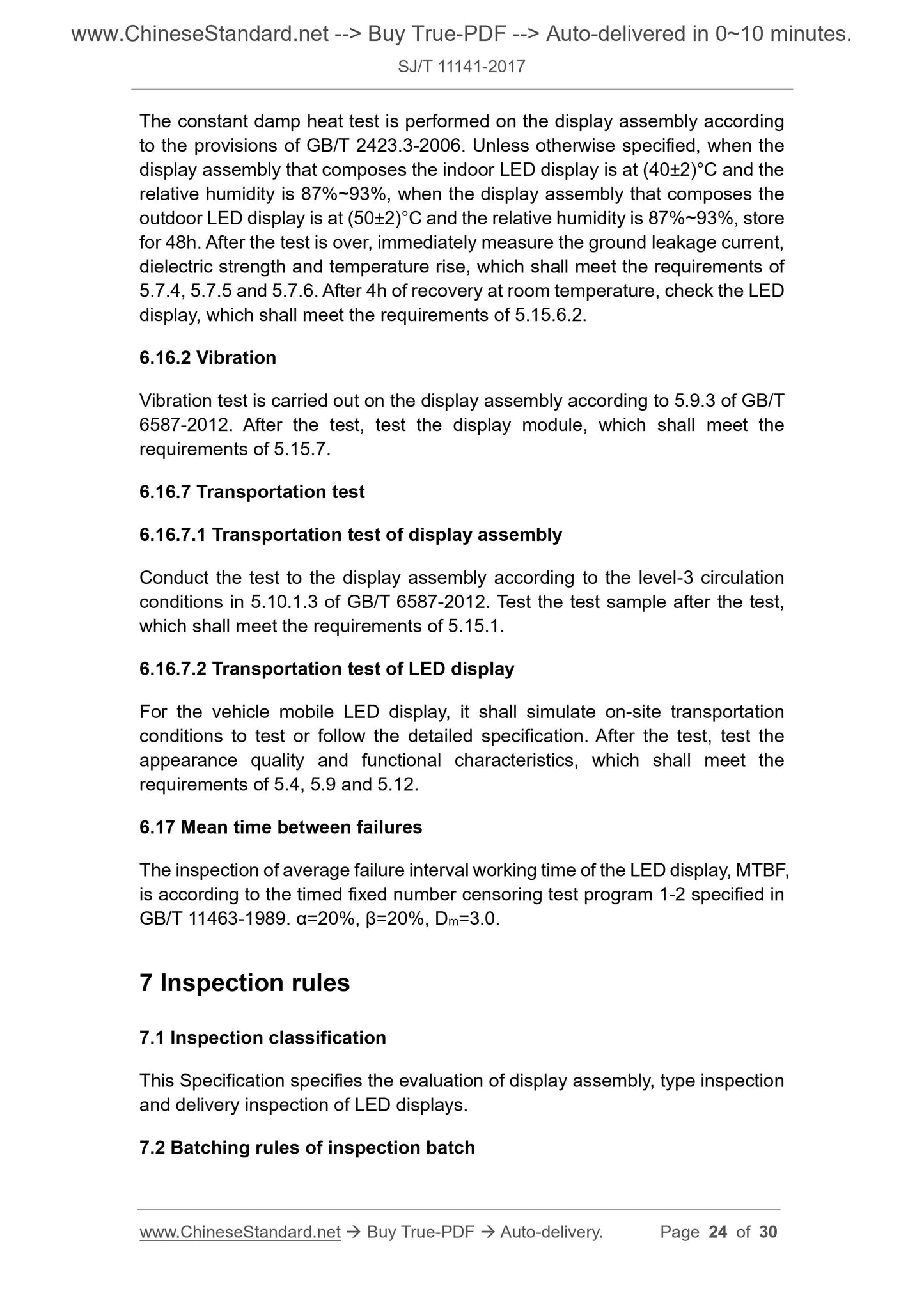1
/
of
12
PayPal, credit cards. Download editable-PDF and invoice in 1 second!
SJ/T 11141-2017 English PDF (SJ/T11141-2017)
SJ/T 11141-2017 English PDF (SJ/T11141-2017)
Regular price
$430.00 USD
Regular price
Sale price
$430.00 USD
Unit price
/
per
Shipping calculated at checkout.
Couldn't load pickup availability
Delivery: 3 seconds. Download true-PDF + Invoice.
Get QUOTATION in 1-minute: Click SJ/T 11141-2017
Historical versions: SJ/T 11141-2017
Preview True-PDF (Reload/Scroll if blank)
SJ/T 11141-2017: Generic specification for LED displays
SJ/T 11141-2017
SJ
ELECTRONICS INDUSTRY STANDARD
OF THE PEOPLE’S REPUBLIC OF CHINA
ICS 31.120
L 47
File No.:
Replacing SJ/T 11141-2012
Generic specification for LED displays
ISSUED ON: NOVEMBER 07, 2017
IMPLEMENTED ON: JANUARY 01, 2018
Issued by: Ministry of Industry and Information Technology of the
People's Republic of China
Table of Contents
Foreword ... 3
1 Scope ... 5
2 Normative references ... 5
3 Terms, definitions and symbols ... 6
4 Classification ... 9
5 Requirements ... 10
6 Inspection and test methods ... 18
7 Inspection rules ... 24
8 Marks, packaging, transportation, storage ... 29
Generic specification for LED displays
1 Scope
This Specification specifies terms and definitions, classification, technical
requirements, inspection methods, inspection rules as well as marks,
packaging, transportation and storage requirements of LED displays.
This Specification is applicable to LED display products.
2 Normative references
The following referenced documents are indispensable for the application of
this document. For dated references, only the edition cited applies. For undated
references, the latest edition of the referenced document (including any
amendments) applies.
GB/T 191, Packaging and storage marks
GB/T 2423.1-2008, Environmental testing - Part 2: Test methods - Tests A:
Cold
GB/T 2423.2-2008, Environmental testing - Part 2: Test methods - Tests B:
Dry heat
GB/T 2423.3-2006, Environmental testing for electric and electronic products
- Part 2: Testing method test Cab: Damp heat Steady state
GB/T 2828.1-2012, Sampling procedures for inspection by attributea - Part
1: Sampling schemes indexed by acceptance quality limit (AQL) for lot-by-lot
inspection
GB 4208-2008, Degrees of protection provided by enclosure (IP code)
GB 4943.1-2011, Information technology equipment -Safety - Part 1: General
requirements
GB/T 6388-1986, Transportation package shipping mark
GB/T 6587-2012, General specification for electronic measuring instruments
GB 9254-2008, Information technology equipment - Radio disturbance
characteristics - Limits and methods of measurement
GB/T 11463-1989, Reliability test for electronic measuring instruments
GB/T 17618-2015, Information technology equipment - Immunity
characteristics - Limits and methods of measurement
GB 20943-2013, Minimum allowable values of energy efficiency and
evaluating values of energy conservation for single voltage external AC-DC
and AC-AC power supplies
SJ/T 10463-1993, Requirements of packing, marking and storage for
electronic measuring instruments
SJ/T 11281-2017, Measure methods of light emitting diode (LED) displays
CIE 1931, Color space
3 Terms, definitions and symbols
For the purposes of this document, the following terms and definitions apply.
3.1 LED displays
A device for displaying text, image, video and other information with LED pixels,
usually including basic components such as LED panel and display control
system; it may also include support system and so on. It may adopt one-piece
or split structure.
3.2 LED panel
It is spliced by one or several display modules. It may be controlled by the
display control system to complete the screen display.
3.3 display control system
It is usually composed of a video processor, signal conditioning transmitter,
signal receiving distributor and related playback control display software and so
on. It may also include various signal sources and matrix switchers.
3.4 support system
Supporting equipment for the LED display. It usually includes power supply and
distribution system, audio system, temperature regulation system, lightning
protection system and security system.
3.5 gray scale
The maximum brightness level of any primary color of the LED display from the
darkest to the brightest.
3.16 Pixel intensity uniformity; IPU
The consistency of the luminous intensity of each pixel in the LED display.
3.17 luminance uniformity of display module; IMU
The brightness consistency of each display module, which is called luminance
uniformity of module.
3.18 color un-uniformity of display module; CMJ
The inconsistency of the chromaticity of each display module, which is called
color un-uniformity of module.
3.19 luminance uniformity of display assembly; IGU
The brightness consistency between modules, which is called luminance
uniformity of assembly.
3.20 color un-uniformity of display assembly; CGJ
The inconsistency of chromaticity between modules, which is called color un-
uniformity of assembly.
3.21 maximum contrast ratio
Under a certain environmental illumination, the ratio of the maximum luminance
of the LED display to the background luminance.
3.22 out of control pixel
LED pixel whose light-emitting state does not match the display state required
by the control.
3.23 refresh frame frequency
The number of times of updates per second that the LED display displays.
3.24 refresh ratio
The number of times of displayed information per second that the LED display
displays.
3.25 critical defect
The following provisions are critical defects:
1) Defects that may cause hazards or unsafe conditions to the use and
maintenance of the LED display or personnel related to it;
The LED displays are divided into planar and non-planar types according to the
appearance of panel.
4.6 Pixel pitch
According to the pixel pitch, the LED display is divided into common pitch and
small pitch.
5 Requirements
5.1 Design and structure
5.1.1 Hardware
When designing LED displays, it shall perform designs on safety,
electromagnetic compatibility, reliability, maintainability, ease of use,
environmental adaptability and energy-saving. If designing serialized products,
the design principles of serialization, standardization, modularization and
backward compatibility shall be followed, according to relevant standards.
5.1.2 Software
The configured software shall be adapted to the hardware resources of the
hardware system. In addition to meeting application functions, corresponding
maintenance and testing procedures shall also be provided. The software of the
same series of products shall follow the design principles of serialization,
standardization, modularization, Chinese localization and backward
compatibility. The character set encoding and font shall comply with the relevant
standards.
5.1.3 Structure
5.1.3.1 Structural design shall follow the requirements of standardization and
serialization and meet the characteristics of ergonomics. And it shall have a
good heat dissipation structure and heat dissipation measures.
5.1.3.2 The display structure of the LED display can be made of steel, aluminum,
plastic and other materials. The structure is safe and robust.
5.1.3.3 The common dot pitches are: 0.7, 0.8, 1.0, 1.2, 1.4, 1.6, 1.8, 1.9, 2.0,
2.4, 2.5, 2.8, 3.0, 4.0, 4.7, 5.0, 6.0, 7.62, 8.0, 10, 12, 14, 16, 18, 20, 22, 25, 28,
31.25, 40, in millimeters (mm).
5.1.4 Packaging materials
In packaging design, priority shall be given to materials that meet environmental
The test voltage specified in 6.8.5 is applied between the two poles of the power
supply of the display assembly constituting the LED display, between the two
poles of the power supply and the protective ground. No insulation breakdown
shall occur during the test.
5.7.6 Temperature rise
After the LE...
Get QUOTATION in 1-minute: Click SJ/T 11141-2017
Historical versions: SJ/T 11141-2017
Preview True-PDF (Reload/Scroll if blank)
SJ/T 11141-2017: Generic specification for LED displays
SJ/T 11141-2017
SJ
ELECTRONICS INDUSTRY STANDARD
OF THE PEOPLE’S REPUBLIC OF CHINA
ICS 31.120
L 47
File No.:
Replacing SJ/T 11141-2012
Generic specification for LED displays
ISSUED ON: NOVEMBER 07, 2017
IMPLEMENTED ON: JANUARY 01, 2018
Issued by: Ministry of Industry and Information Technology of the
People's Republic of China
Table of Contents
Foreword ... 3
1 Scope ... 5
2 Normative references ... 5
3 Terms, definitions and symbols ... 6
4 Classification ... 9
5 Requirements ... 10
6 Inspection and test methods ... 18
7 Inspection rules ... 24
8 Marks, packaging, transportation, storage ... 29
Generic specification for LED displays
1 Scope
This Specification specifies terms and definitions, classification, technical
requirements, inspection methods, inspection rules as well as marks,
packaging, transportation and storage requirements of LED displays.
This Specification is applicable to LED display products.
2 Normative references
The following referenced documents are indispensable for the application of
this document. For dated references, only the edition cited applies. For undated
references, the latest edition of the referenced document (including any
amendments) applies.
GB/T 191, Packaging and storage marks
GB/T 2423.1-2008, Environmental testing - Part 2: Test methods - Tests A:
Cold
GB/T 2423.2-2008, Environmental testing - Part 2: Test methods - Tests B:
Dry heat
GB/T 2423.3-2006, Environmental testing for electric and electronic products
- Part 2: Testing method test Cab: Damp heat Steady state
GB/T 2828.1-2012, Sampling procedures for inspection by attributea - Part
1: Sampling schemes indexed by acceptance quality limit (AQL) for lot-by-lot
inspection
GB 4208-2008, Degrees of protection provided by enclosure (IP code)
GB 4943.1-2011, Information technology equipment -Safety - Part 1: General
requirements
GB/T 6388-1986, Transportation package shipping mark
GB/T 6587-2012, General specification for electronic measuring instruments
GB 9254-2008, Information technology equipment - Radio disturbance
characteristics - Limits and methods of measurement
GB/T 11463-1989, Reliability test for electronic measuring instruments
GB/T 17618-2015, Information technology equipment - Immunity
characteristics - Limits and methods of measurement
GB 20943-2013, Minimum allowable values of energy efficiency and
evaluating values of energy conservation for single voltage external AC-DC
and AC-AC power supplies
SJ/T 10463-1993, Requirements of packing, marking and storage for
electronic measuring instruments
SJ/T 11281-2017, Measure methods of light emitting diode (LED) displays
CIE 1931, Color space
3 Terms, definitions and symbols
For the purposes of this document, the following terms and definitions apply.
3.1 LED displays
A device for displaying text, image, video and other information with LED pixels,
usually including basic components such as LED panel and display control
system; it may also include support system and so on. It may adopt one-piece
or split structure.
3.2 LED panel
It is spliced by one or several display modules. It may be controlled by the
display control system to complete the screen display.
3.3 display control system
It is usually composed of a video processor, signal conditioning transmitter,
signal receiving distributor and related playback control display software and so
on. It may also include various signal sources and matrix switchers.
3.4 support system
Supporting equipment for the LED display. It usually includes power supply and
distribution system, audio system, temperature regulation system, lightning
protection system and security system.
3.5 gray scale
The maximum brightness level of any primary color of the LED display from the
darkest to the brightest.
3.16 Pixel intensity uniformity; IPU
The consistency of the luminous intensity of each pixel in the LED display.
3.17 luminance uniformity of display module; IMU
The brightness consistency of each display module, which is called luminance
uniformity of module.
3.18 color un-uniformity of display module; CMJ
The inconsistency of the chromaticity of each display module, which is called
color un-uniformity of module.
3.19 luminance uniformity of display assembly; IGU
The brightness consistency between modules, which is called luminance
uniformity of assembly.
3.20 color un-uniformity of display assembly; CGJ
The inconsistency of chromaticity between modules, which is called color un-
uniformity of assembly.
3.21 maximum contrast ratio
Under a certain environmental illumination, the ratio of the maximum luminance
of the LED display to the background luminance.
3.22 out of control pixel
LED pixel whose light-emitting state does not match the display state required
by the control.
3.23 refresh frame frequency
The number of times of updates per second that the LED display displays.
3.24 refresh ratio
The number of times of displayed information per second that the LED display
displays.
3.25 critical defect
The following provisions are critical defects:
1) Defects that may cause hazards or unsafe conditions to the use and
maintenance of the LED display or personnel related to it;
The LED displays are divided into planar and non-planar types according to the
appearance of panel.
4.6 Pixel pitch
According to the pixel pitch, the LED display is divided into common pitch and
small pitch.
5 Requirements
5.1 Design and structure
5.1.1 Hardware
When designing LED displays, it shall perform designs on safety,
electromagnetic compatibility, reliability, maintainability, ease of use,
environmental adaptability and energy-saving. If designing serialized products,
the design principles of serialization, standardization, modularization and
backward compatibility shall be followed, according to relevant standards.
5.1.2 Software
The configured software shall be adapted to the hardware resources of the
hardware system. In addition to meeting application functions, corresponding
maintenance and testing procedures shall also be provided. The software of the
same series of products shall follow the design principles of serialization,
standardization, modularization, Chinese localization and backward
compatibility. The character set encoding and font shall comply with the relevant
standards.
5.1.3 Structure
5.1.3.1 Structural design shall follow the requirements of standardization and
serialization and meet the characteristics of ergonomics. And it shall have a
good heat dissipation structure and heat dissipation measures.
5.1.3.2 The display structure of the LED display can be made of steel, aluminum,
plastic and other materials. The structure is safe and robust.
5.1.3.3 The common dot pitches are: 0.7, 0.8, 1.0, 1.2, 1.4, 1.6, 1.8, 1.9, 2.0,
2.4, 2.5, 2.8, 3.0, 4.0, 4.7, 5.0, 6.0, 7.62, 8.0, 10, 12, 14, 16, 18, 20, 22, 25, 28,
31.25, 40, in millimeters (mm).
5.1.4 Packaging materials
In packaging design, priority shall be given to materials that meet environmental
The test voltage specified in 6.8.5 is applied between the two poles of the power
supply of the display assembly constituting the LED display, between the two
poles of the power supply and the protective ground. No insulation breakdown
shall occur during the test.
5.7.6 Temperature rise
After the LE...
Share
